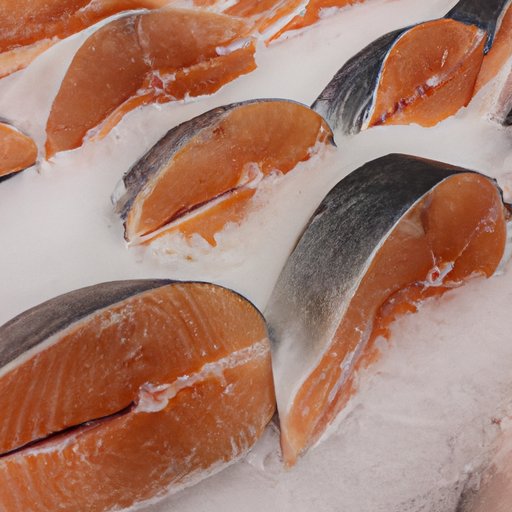
Introduction
Salmon is a delicious and healthy seafood that can be easily frozen for later use. But how long can it last in your freezer before it goes bad? This article aims to provide a comprehensive guide on how to freeze salmon, debunk common myths and misconceptions, and provide tips on how to maximize its shelf life.
A Guide to Freezing Salmon: How Long Can It Last in Your Freezer?
The ideal storage temperature for freezing salmon is at 0°F or lower. This will help preserve the quality and freshness of the fish for a longer period of time. However, different factors can affect the longevity of salmon in the freezer.
The type of salmon can impact how long it can be stored in the freezer. Wild salmon, for instance, has a shorter shelf life than farmed salmon. The quality of the fish also plays an important role. Fresh, high-quality salmon will last longer in the freezer than one that has started to deteriorate. Lastly, proper packaging is crucial in preserving the quality of the salmon in the freezer.
To properly freeze salmon, start by cleaning and preparing the fish. Remove the scales, guts, and bones, and cut it into portions. Pat dry with paper towels to remove any excess moisture. Wrap each portion tightly in plastic wrap, then follow with a layer of aluminum foil. Label with the date and type of salmon, and place in the freezer.
Salmon Freezing Myths: Debunking Common Misconceptions
One common misconception is that frozen salmon can last forever. While technically it can, the quality will start to decline over time. It is recommended to consume frozen salmon within six months for optimal flavor and texture.
Storing salmon in the freezer for too long can also result in freezer burn, which can cause the salmon to become dry and lose flavor. To avoid freezer burn, make sure to wrap the salmon tightly and use it within the recommended time frame.
From Fresh to Frozen: Top Tips for Preserving Your Salmon
To preserve the texture and taste of your salmon when thawed, follow these tips:
– Avoid thawing salmon in the microwave, as this can result in uneven cooking and dryness.
– Thaw salmon in the refrigerator overnight for the best results.
– If you’re in a hurry, thaw salmon in cold water for around 30-40 minutes.
– Once thawed, cook the salmon as soon as possible.
How to Tell If Your Frozen Salmon Has Gone Bad
If your frozen salmon has gone bad, there will be noticeable changes in its color and texture. It may have a strong fishy smell, and the flesh may appear dry, discolored, or slimy. If you suspect that the salmon has gone bad, it’s best to throw it away to avoid food poisoning.
Saving Money on Seafood: Maximizing Your Salmon’s Shelf Life
Buying salmon in bulk and freezing it properly can help you save money on seafood. Just make sure to follow the proper steps for freezing to maximize its shelf life.
Frozen salmon can be used in a variety of recipes, such as stir-fries, pasta dishes, and salads. Whether you’re using fresh or frozen salmon, make sure to handle it properly to ensure the best taste and quality.
Conclusion
In conclusion, freezing salmon is a great way to preserve its quality and prolong its shelf life. By following the proper steps for freezing and thawing, you can enjoy delicious and healthy salmon for months to come. Remember to keep an eye on the recommended storage time and to look out for signs of spoilage. With these tips, you can confidently freeze salmon and save money while enjoying tasty meals.




